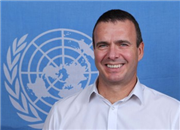
Jaco Cilliers
Country Director, UNDP in India
UNDP
The union government in May partnered with UNDP India and launched Namami Gange, a massive rural sanitation and river cleaning initiative. Jaco Cilliers, country director, UNDP India, talks to Swati Chandra about the multidimensional approach of the programme that aims to clean up India’s holiest river, improve rural sanitation and scale up livelihood.
What was the reason for supporting the Ganga rejuvenation plan?
We work in close partnership with the government on various important issues. Rejuvenating the Ganga is something that the prime minister and the entire country have put their full commitment behind. It is also an opportunity for the government to demonstrate and scale up a holistic approach to clean the river: one that looks at it as a way to improve both sanitation and livelihood. We believe that the improved sanitation linked to livelihood and the management of the same by communities can improve the quality of water in the river.
What would be UNDP’s role in this programme?
UNDP is implementing activities such as creating and strengthening community institutions, local skills and practices in remote areas, introducing innovative community monitoring through mobile apps and documenting GIS-based systems as well as showcasing success stories and community voices in an integrated manner. The government is actually aiming to develop [what] is essentially a holistic rural development model.
The project is [being] implemented in 78 villages of Jharkhand which are on the banks of the river and where over 90 percent of the population defecates in the open. We aim to reduce contamination of the river and improve the well-being of communities in these villages. Around 45,000 villages are expected to benefit from this partnership with an improved health and quality of life through better sanitation practices.
The partnership focuses on three types of interventions. First is improving sanitation practices through access to improved sanitation facilities, thus ending open defecation in these villages. Second would be strengthening livelihood of villagers with sanitation infrastructure by promoting cost-effective, appropriate, solid and liquid waste management. This would include water harvesting ponds, biogas units, smokeless cooking stoves, etc. Third area would be empowering local governance institutions like village panchayats, village committees and women’s self-help groups to effectively maintain facilities established for improved sanitation in the villages.
Will the cleaning of the Ganga also involve tackling sewage/open drains which enter the river?
Our approach is to look at a set of actions that reduce the flow of waste into the river. We will be introducing village garbage management, solid and liquid waste management practices, use of bio-digesters, build bathing ghats, toilets and crematoriums in designated areas.
“Next decade is India’s decade”
Jaco Cilliers on India’s performance with regard to the Sustainable Development Goals (SDGs):
The next decade is India’s decade and the country will be playing a leading role in determining the success of the SDGs as it is strongly committed towards it. There is a convergence of ‘sab ka saath, sab ka vikas’ agendas with the SDGs.
The swift response by the government for moving ahead on the nationalising of implementation of the SDGs is noteworthy. The NITI Aayog has been assigned the role to coordinate the SDGs in India. It has undertaken the task of mapping of schemes pertaining to SDGs and targets, and has identified lead and supporting ministries for each of the targets. This is indicative of the government approach to the SDGs. Similarly, states have been advised to undertake similar mapping of their schemes, including centrally sponsored schemes. In addition, the ministry of statistics and programme implementation (MoSPI) has been leading discussions on the global indicator framework for SDGs. Further, the central government has decided to replace the five-year planning exercise with a 15-year National Development Agenda (2030) that seeks to merge long-term planning, regular reviews and stringent monitoring.
State governments are a key to the country’s progress on the SDG agenda as they are best placed to ‘put people first’ and ensure ‘no one is left behind’. Programmes such as Swachh Bharat, Make in India, Skill India are at the core of the SDGs. There is an urgent need to focus on local governments for SDG implementation. Out of the 17 SDGs, 15 are directly related to activities carried out by local governments in India. We have tremendous examples where state governments, panchayats and communities are taking the lead. India is a global example of how the SDG mainstreaming/implementing process is being undertaken.
Who conceived the idea of the Jharkhand model of Ganga rejuvenation?
The ministry of water resources, National Mission for Clean Ganga, and the government of Jharkhand must be given full credit for this initiative. UNDP is playing a supporting role and in doing so, we are influenced by local knowledge, and the needs of communities living on the banks of the Ganga, in particular women.
Will this model also be implemented in the other states through which the Ganga flows?
UNDP is privileged to partner with state governments across the country. We are ready to support the government in addressing development priorities of the country.
|